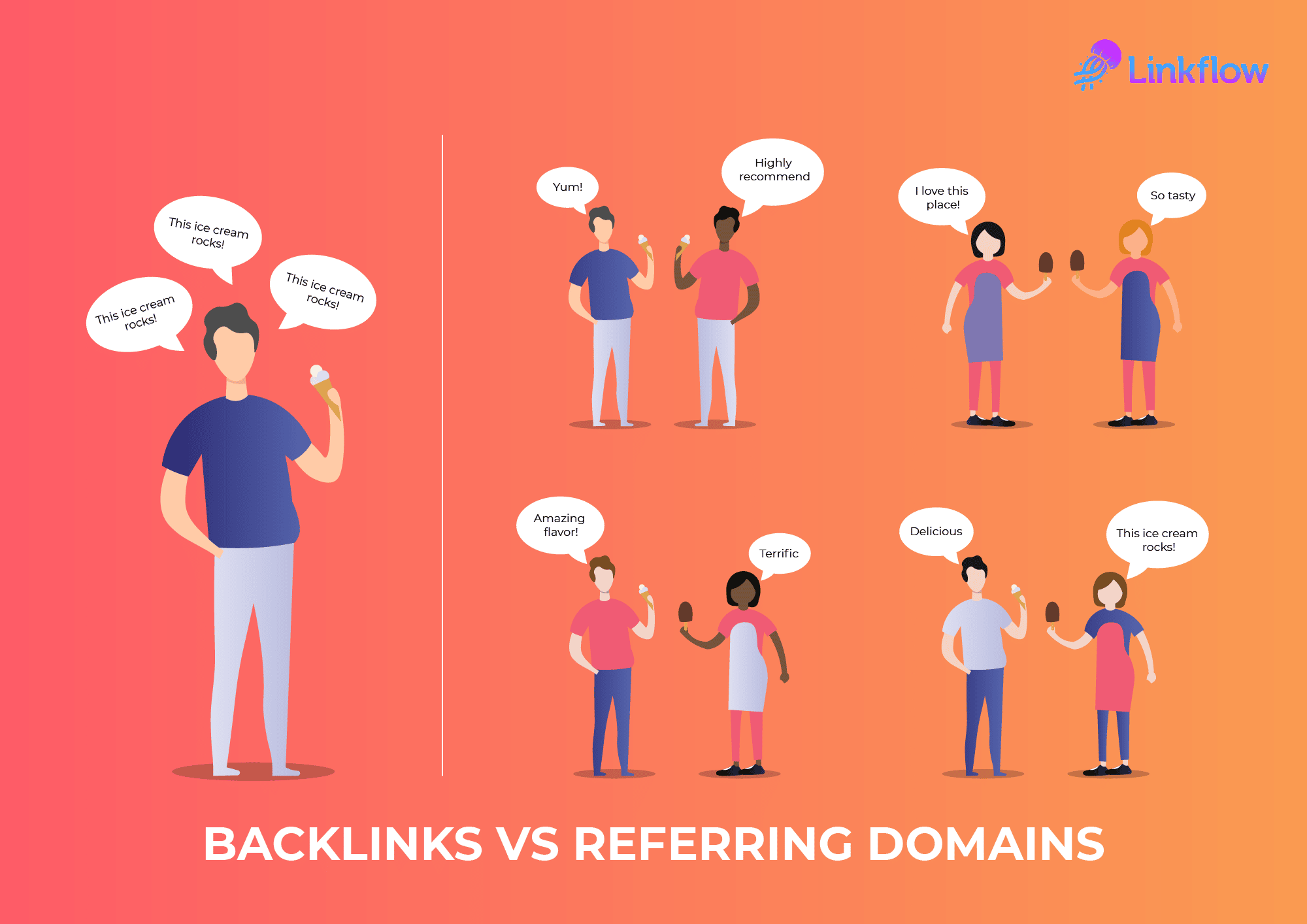
Are you considering building links to your website? If so, you’ve probably come across both of the terms “backlinks” and “referring domains.” It may seem like they can be used interchangeably, but they’re quite different and it’s important to understand their relationship.
What is a Backlink?
A backlink, also known as an inbound link or incoming link, is a hyperlink on one website that directs users to another website. In simpler terms, it’s a link from one web page to another.
Every time you link out to someone else’s website, you’re providing a backlink to them. Thinking about the content you create, and where you source your information, you probably have a collection of websites in mind that you frequently link to.
Each time you link to a single website, that’s an additional backlink.
Why are Backlinks Important?
Backlinks serve as a vote of confidence or endorsement from one website to another. When you link out to someone else’s website, you’re essentially telling search engines and readers that you trust the quality and validity of their content.
The more links you have pointing to your website, the more trust you appear to have. That’s why backlinks are such an important piece of SEO (search engine optimization).
These votes of confidence improve your authority and relevance can improve keyword rankings and drive organic search traffic.
What is a Referring Domain?
A referring domain, in the context of websites and SEO, is a unique website from which a backlink originates. It represents the website that contains a backlink leading to another website.
There will always be fewer referring domains compared to backlinks. Unlike backlinks, no matter how many times you link to a single website, it only counts as a one referring domain.
How Do Referring Domains Affect SEO?
When people say that backlinks are an important SEO factor, they’re really talking about referring domains.
Each website that links to yours counts as that vote of confidence. Multiple backlinks from a single site to yours doesn’t stack that confidence higher.
Think of it this way: If you owned an ice cream store, would you rather have 100 unique customers recommend your business to each of their friends, or a single customer tell their best friend “this ice cream rocks!” 100 times?
Types of Backlinks
You’ll want a collection of different types of referring domains and backlinks pointing to your website.
Natural
Sometimes backlinks happen naturally. In fact, it’s how search engines expect all backlinks to come to fruition. That’s a little unrealistic, considering 91% of web pages have no backlinks at all. Which in turn means they are likely to receive no organic traffic at all.
However, sometimes it just makes sense to link out to another website, and so you do. A great way to get more natural links is to publish a study or data. This type of content is one of the most commonly linked.
Editorial
These are PR backlinks. They are typically what first comes to mind when new SEO professionals start getting into the world of link building. These links are typically placed on high DR websites, yes, but they’re also usually nofollow. This means they don’t count as that vote of confidence.
Editorial backlinks are typically designed to drive referral traffic rather than organic traffic. Therefore, these inbound links are more of a temporary boost than a long-term improvement.
Manual
These are the links you’re actively building through outreach, guest posting, or other link-building strategies.
When you hire an agency for link building services, they’ll be gaining manual backlinks for you. Note that a good agency will be adding referring domains vs backlinks, as this will be more likely to impact SEO.
Reciprocal
These are links where two or more websites link to each other – basically a link swap. Reciprocal links, or link exchanges, can either be natural or manual.
We built out an entire guide to link exchanges, as there are so many things to keep in mind when you go this route of getting more referring domains.
Backlinks vs. Referring Domains: Which one matters more?
The answer is referring domains. Sometimes a client’s site has only a handful of referring domains but thousands of backlinks. This typically happens when a small number of referring domains send a disproportionate number of links to their site, which can be an indicator of spammy link building tactics.
Many referring domains that link to a website thousands of times have embedded a target URL in multiple locations–in sidebars, footers, and even headers that appear on every one of their pages.
Google devalues these kinds of links and, if it sees a trend emerging in your backlink profile, the search engine will take harsh steps to make sure you’re not gaming the algorithm–typically by hitting you with a Manual Action penalty.
In Google’s eyes, a high number of referring domains is more valuable than a lot of backlinks, since it infers that a large number of domains find your website useful and credible.
The greater the number of unique, authoritative sources that share an opinion about a website, the more reliable it’s considered to be.
How to Evaluate Backlinks and Referring Domains
We recommend you evaluate referring domains vs backlinks. The actual link matters significantly less than the referring domain.
Here are things to check:
- Domain authority – your goal should be 50+ DR
- Traffic – you want sites that actually get traffic
- Backlink profile – it’s good to see a healthy profile free from spammy links
- Content – you’re looking for high quality content
This is how a good link building agency will find high quality sites to generate backlinks for clients.

How to Check Your Referring Domains and Backlinks
You can check backlinks and referring domains using an SEO tool like Ahrefs or Semrush. You can review your link profile, domain rating, and see which web pages on your site have the most referring domain.
Here’s the process in Ahrefs to see how many backlinks and referring domains you have and determine their quality.
You may also want to look at the referring domains and backlinks of other websites so you can compare their link profile to yours.
Backlink to Referring Domain Ratio
The backlink to referring domain ratio gives us the average number of links the domain sends to a site:
BL:DR ratio = (# of backlinks) / (# of referring domains)
Ideally, the best backlinks to referring domain ratio is 1:1. Realistically, it’s extremely rare to find a site with a 1:1 ratio, but the closer you can get, the better. It’s ideal to have the backlink value in the single digits.
The key takeaway is that once you acquire a link from a domain, additional links from the same referring domain have diminishing returns. Each additional link dilutes the “link juice” to your website, so it’s best to move on and pursue backlinks from other sites.
Can you have too many backlinks?
There’s no such thing as having too many high quality backlinks. However, if you have a large number of backlinks from only a handful of referring domains, it can become a problem. Typically search engines ignore spammy links, as their algorithm is designed to identify them.
However, if they suspect you acquired these link nefariously, you could be hit with a penalty. In that case, disavow the links. Be sure to speak with an SEO professional before doing so since disavowing the wrong links or too many of them can be as or more harmful.
Again, the only time we recommend you disavow backlinks is when you have a “manual action” or penalty in your Google Search Console instance.
In the earliest days of search, link building manipulation was an effective way to boost organic rankings. Webmasters built or even paid for relationships with a handful of websites to create and direct tons of backlinks back and forth. This is called a paid linking scheme and is entirely different from how reputable agencies acquire referring domains and backlinks for clients.
Once Google caught on to the manipulation, it launched (in 2012) what became known as the Penguin algorithm update to devalue sites that were engaging in link building schemes. Many sites were rightfully penalized by the update, and the algorithm has become increasingly sophisticated to detect and quash new schemes.
That’s why building editorial links with high quality sites is the best, and safest, way to enhance your website’s link profile.
Is it possible to have too many referring domains?
The number of referring domains depends on their quality. A large number of low quality referring domains is a surefire way to put your site at risk of a manual action penalty from Google since they can be interpreted as link spam.
On the other hand, Google looks at a large number of high quality referring domains as a signal of an authoritative website. Acquiring a high number of quality backlinks takes time and effort, but it pays high SEO dividends in the long term.
How the Best Link Building Agencies Get Backlinks
Website backlinks and referring domains tell us a lot about the strength of a link profile. A good agency will take the time to understand their relationship and develop an effective link building strategy.
Then, they will concoct a plan of action that is tailored to your unique needs and goals, including pages to build links to, at what frequency, and what anchor text
should be used for each link.
Look for a partner that has a large network of contextually-relevant sites they can manually reach out to in order to gain high quality backlinks. Make sure they are open about where and how they source referring domains for your website.

Brittney Fred, SEO Analyst
Brittney has been working in SEO and digital marketing for ten years and specializes in content strategy for the B2B SaaS industry. She is based in Denver, CO and absolutely fits the Denverite stereotype. You’re just as likely to find her hiking, snowboarding, or doing yoga as reading sci-fi or playing video games.
